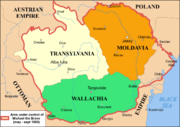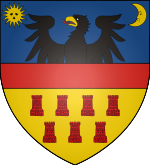
Historical regions of Romania
Encyclopedia


Romania
Romania is a country located at the crossroads of Central and Southeastern Europe, on the Lower Danube, within and outside the Carpathian arch, bordering on the Black Sea...
extended over the following historical regions:
 Wallachia
WallachiaWallachia
Wallachia or Walachia is a historical and geographical region of Romania. It is situated north of the Danube and south of the Southern Carpathians...
:
- Muntenia or Greater WallachiaMunteniaMuntenia is a historical province of Romania, usually considered Wallachia-proper . It is situated between the Danube , the Carpathian Mountains and Moldavia , and the Olt River to the west...
: as part of Wallachia, joined Moldavia in 1859 to create modern Romania; - Oltenia or Lesser WallachiaOlteniaOltenia is a historical province and geographical region of Romania, in western Wallachia. It is situated between the Danube, the Southern Carpathians and the Olt river ....
: as part of Wallachia, joined Moldavia in 1859 to create modern Romania;
 Moldavia
MoldaviaMoldavia
Moldavia is a geographic and historical region and former principality in Eastern Europe, corresponding to the territory between the Eastern Carpathians and the Dniester river...
:
- western MoldaviaMoldaviaMoldavia is a geographic and historical region and former principality in Eastern Europe, corresponding to the territory between the Eastern Carpathians and the Dniester river...
: joined Wallachia in 1859 to create modern Romania; the Hertza regionHertza regionHertza region is the territory of an administrative district of Hertsa in the southern part of Chernivtsi Oblast in southwestern Ukraine, on the Romanian border...
is today in Ukraine; - BucovinaBukovinaBukovina is a historical region on the northern slopes of the northeastern Carpathian Mountains and the adjoining plains.-Name:The name Bukovina came into official use in 1775 with the region's annexation from the Principality of Moldavia to the possessions of the Habsburg Monarchy, which became...
: in Romania between 1918 and World War IIWorld War IIWorld War II, or the Second World War , was a global conflict lasting from 1939 to 1945, involving most of the world's nations—including all of the great powers—eventually forming two opposing military alliances: the Allies and the Axis...
, today divided between Romania and Ukraine; - Bessarabia (eastern Moldavia)BessarabiaBessarabia is a historical term for the geographic region in Eastern Europe bounded by the Dniester River on the east and the Prut River on the west....
(including BudjakBudjakBudjak or Budzhak is a historical region in the Odessa Oblast of Ukraine. Lying along the Black Sea between the Danube and Dniester rivers this multiethnic region was the southern part of Bessarabia...
): in Romania between 1918 and World War IIWorld War IIWorld War II, or the Second World War , was a global conflict lasting from 1939 to 1945, involving most of the world's nations—including all of the great powers—eventually forming two opposing military alliances: the Allies and the Axis...
, today divided between Moldova and Ukraine.
 Dobruja
DobrujaDobruja
Dobruja is a historical region shared by Bulgaria and Romania, located between the lower Danube river and the Black Sea, including the Danube Delta, Romanian coast and the northernmost part of the Bulgarian coast...
:
- Northern Dobrogea (including Snake IslandSnake Island (Black Sea)Snake Island, also known as Serpent Island, , is a Ukrainian island located in the Black Sea near the Danube Delta.The island is populated. A rural settlement of Bile was established in February 2007, which is part of the Vylkove city, Kiliya Raion, Odessa Oblast...
): today in Romania (excepting some Danubian islands and the Snake Island which are located in URSS since 1948 and in Ukraine since 1991); - Southern Dobruja or CadrilaterSouthern DobrujaSouthern Dobruja is an area of north-eastern Bulgaria comprising the administrative districts named for its two principal cities of Dobrich and Silistra...
: in Romania between 1913 and 1940, today in BulgariaBulgariaBulgaria , officially the Republic of Bulgaria , is a parliamentary democracy within a unitary constitutional republic in Southeast Europe. The country borders Romania to the north, Serbia and Macedonia to the west, Greece and Turkey to the south, as well as the Black Sea to the east...
.
Wallachia, western Moldavia, and Dobruja are sometimes referred collectively as the Regat
Romanian Old Kingdom
The Romanian Old Kingdom is a colloquial term referring to the territory covered by the first independent Romanian nation state, which was composed of the Danubian Principalities—Wallachia and Moldavia...
(The Kingdom), as they formed the Romanian "Old" Kingdom before World War I
World War I
World War I , which was predominantly called the World War or the Great War from its occurrence until 1939, and the First World War or World War I thereafter, was a major war centred in Europe that began on 28 July 1914 and lasted until 11 November 1918...
.
 Transylvania
TransylvaniaTransylvania
Transylvania is a historical region in the central part of Romania. Bounded on the east and south by the Carpathian mountain range, historical Transylvania extended in the west to the Apuseni Mountains; however, the term sometimes encompasses not only Transylvania proper, but also the historical...
(and Partium
Partium
Partium or Részek is the name given in Hungarian to the region located to the north and west of Transylvania.-Origin of the name:...
):
- former principality of TransylvaniaTransylvaniaTransylvania is a historical region in the central part of Romania. Bounded on the east and south by the Carpathian mountain range, historical Transylvania extended in the west to the Apuseni Mountains; however, the term sometimes encompasses not only Transylvania proper, but also the historical...
: in Romania since 1918; - BanatBanatThe Banat is a geographical and historical region in Central Europe currently divided between three countries: the eastern part lies in western Romania , the western part in northeastern Serbia , and a small...
(part of the historic Partium region): since 1918 divided between Romania, SerbiaSerbiaSerbia , officially the Republic of Serbia , is a landlocked country located at the crossroads of Central and Southeast Europe, covering the southern part of the Carpathian basin and the central part of the Balkans...
and HungaryHungaryHungary , officially the Republic of Hungary , is a landlocked country in Central Europe. It is situated in the Carpathian Basin and is bordered by Slovakia to the north, Ukraine and Romania to the east, Serbia and Croatia to the south, Slovenia to the southwest and Austria to the west. The...
; - CrişanaCrisanaCrișana is a geographical and historical region divided today between Romania and Hungary, named after the Criș River and its three tributaries: the Crișul Alb, Crișul Negru and Crișul Repede....
(part of the historic Partium region): since 1918 divided between Romania and Hungary; - MaramureşMaramuresMaramureș may refer to the following:*Maramureș, a geographical, historical, and ethno-cultural region in present-day Romania and Ukraine, that occupies the Maramureș Depression and Maramureș Mountains, a mountain range in North East Carpathians...
(part of the historic Partium region): southern part in Romania since 1918, northern part currently in UkraineUkraineUkraine is a country in Eastern Europe. It has an area of 603,628 km², making it the second largest contiguous country on the European continent, after Russia...
.
During or after World War II
World War II
World War II, or the Second World War , was a global conflict lasting from 1939 to 1945, involving most of the world's nations—including all of the great powers—eventually forming two opposing military alliances: the Allies and the Axis...
Romania lost some of the above mentioned regions: Southern Dobruja (in 1940), Northern Bukovina and Hertza (in 1940), the Snake Island (in 1948) and Bessarabia (in 1940). Transnistria
Transnistria (World War II)
Transnistria Governorate was a Romanian administered territory, conquered by the Axis Powers from the Soviet Union during Operation Barbarossa, and occupied from 19 August 1941 to 29 January 1944...
was also occupied for a short time during World War II
World War II
World War II, or the Second World War , was a global conflict lasting from 1939 to 1945, involving most of the world's nations—including all of the great powers—eventually forming two opposing military alliances: the Allies and the Axis...
by Romania (from 1941 to 1944).
See also
- Development regions of RomaniaDevelopment regions of RomaniaThe development regions of Romania refer to the eight regional divisions created in Romania in 1998 in order to better co-ordinate regional development as Romania progressed towards accession to the European Union. The development regions correspond to NUTS II-level divisions in European Union...
— divisions used currently and which are not based on the borders of historical regions; - Counties of RomaniaCounties of RomaniaThe 41 judeţe and the municipality of Bucharest comprise the official administrative divisions of Romania. They also represent the European Union' s NUTS-3 geocode statistical subdivision scheme of Romania.-Overview:...
; - Movement for the unification of Romania and Moldova.

